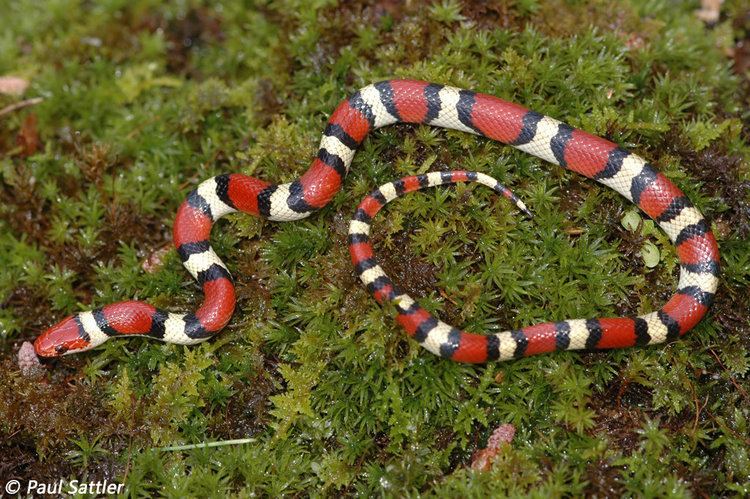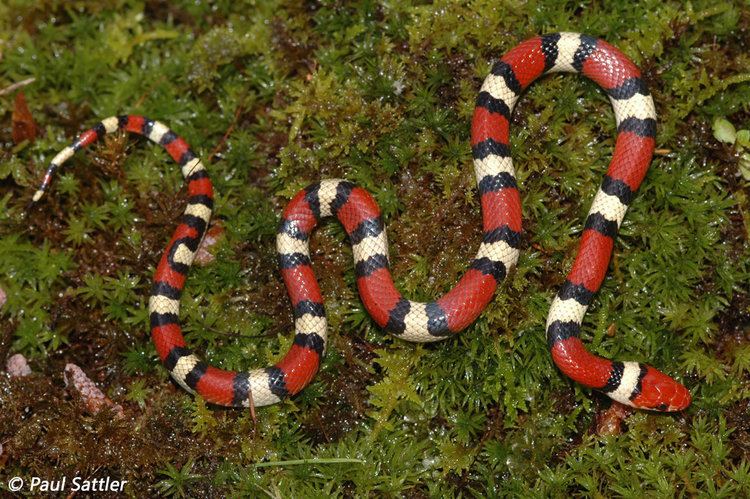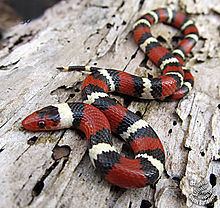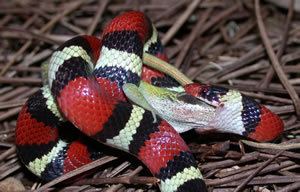Scientific name Lampropeltis elapsoides Rank Species | Phylum Chordata Suborder Serpentes Genus Lampropeltis Higher classification Kingsnakes | |
 | ||
Similar Snake, Kingsnakes, Reptile, Sinaloan milk snake, Cemophora | ||
Lampropeltis elapsoides, commonly known as the scarlet kingsnake, is a species of kingsnake found in the southeastern and eastern portions of the United States. Like all kingsnakes, they are nonvenomous. They are found in pine flatwoods, hydric hammocks, pine savannas, mesic pine-oak forests, prairies, cultivated fields, and a variety of suburban habitats; it is not unusual for people to find scarlet kingsnakes in their swimming pools, especially during the spring. Until recently - and for much of the 20th century - scarlet kingsnakes were considered a sub-species of milksnakes. However, Pyron & Bubrink demonstrated the phylogenetic distinction of this species and its closer relationship to the mountain kingsnakes of the southwestern United States. These largely fossorial snakes are the smallest of all species within the genus Lampropeltis, usually ranging from 40 to 50 cm (16 to 20 in) at maturity. The maximum recorded length is 68.4 cm (26.9 in). Hatchlings range in size from 8 to 18 cm (3.1 to 7.1 in).
Contents

Scarlet kingsnake lampropeltis triangulum elapsoides
Taxonomy

The generic name, Lampropeltis, is derived from the Ancient Greek lamprós (λαμπρος) meaning "shiny" and peltas (πελτας) meaning "shield", after the sheen of their scales. Its specific name, elapsoides, is a Latinization of the Greek word éllops (ελλοπς) which refers to coral and was used to describe the nineteenth century genus, Elaps (type genus of the family Elapidae), which included the coral snake (Micrurus fulvius), a venomous species which the scarlet kingsnake resembles and with which the scarlet kingsnake is partly sympatric. The range of scarlet kingsnakes extends considerably further north and northeast than the Eastern coral snake.

It was once believed that the scarlet kingsnake intergraded with the Eastern milk snake, which produced a variation once named the coastal plains milk snake (Lampropeltis triangulum temporalis), but this is no longer recognized as a legitimate taxon.
Description
Scarlet kingsnakes have a tricolored pattern of black, red, white, and various shades of yellow bands that appear to mimic the venomous coral snake in a form of Batesian mimicry. A method to help differentiate between venomous and non venomous tricolor snakes in North America is found in the popular phrases "red on yellow, kill a fellow; red on black venom at lack", "red on yellow's a deadly fellow; yellow on black's a friendly Jack" or "If red touches yellow, you're a dead fellow; if red touches black, you're all right, Jack" and "Red and black is a friend of Billy Jack", as well as "Red on black, friend of Jack; red on yellow, kill a fellow", and "red band near black, venom lack; red band near yellow, bite a fellow". However, all of these can phrases can be avoided with tri-colored snakes found east of the Mississippi River with a simple phrase: "Red face, I'm safe." This is in reference to the red snout of scarlet kingsnakes as opposed to the prominent black snouts of the Eastern coral snake.

Scarlet kingsnakes are born with white, black, and red banding. As they mature, scarlet kingsnakes develop varying shades of yellow within geographic areas where this is expressed. In addition, the yellowing is not uniform, but rather the yellowish pigmentation proceeds from lighter to darker from the lowermost scales upward to the dorsum, or "back," presenting a multi-yellowish band. Early expression of yellowing appears as early as 3 months and continues through the first 3 years. As adults age, there is a gradual darkening of the yellowish banding. The yellow pigmentation varies from lemon, school-bus yellow, tangerine, to apricot.

Scarlet kingsnakes are secretive, nocturnal, fossorial snakes and are infrequently seen by people. They are excellent climbers. Scarlet kingsnakes can be found underneath the loose bark on rotting pines (which is a favorite place for them to hide during spring or during heavy rains), under the bark on dying or decaying pines and their stumps, and decaying wood where they hunt for their favorite prey, small snakes & lizards, especially skinks. Hatchling scarlet kingsnakes show a strong pre-disposition for ground skinks, Scincella lateralis, often to the exclusion of other prey items.
